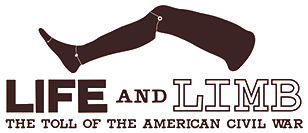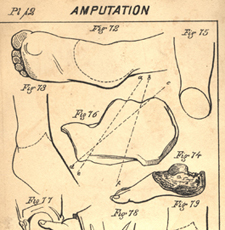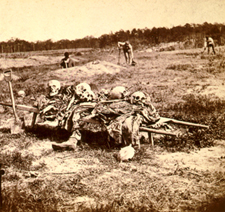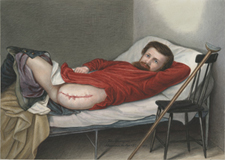
LESSON PLANS
Middle School | High School
The U.S. Civil War: Wounded Soldiers, Disabled Veterans
Grade Level: 5-8
Time Needed: three 40-minute class periods
Description: Students view several primary sources related to the U.S. Civil War, including images. They examine closely the text of the exhibition, Life and Limb: The Toll of the Civil War, to gain understanding of the plight of disabled veterans of the Civil War. Students build on their knowledge of the Civil War veterans by learning about services and support provided to today’s veterans by various government agencies.

Learning Outcomes: Students will be able to:
- examine primary and secondary sources from the U.S. Civil War in order to interpret and analyze history.
- apply concrete observations and facts from primary and secondary sources to assess prior knowledge and expand it.
- identify at least two causes for unprecedented numbers of wounded and dead soldiers during the U.S. Civil War.
- describe briefly the medical and social treatment of wounded and disabled solders during and after the war.
- draw parallels between disabled veterans of the Civil War and those of today

Background Information: The Life and Limb: The Toll of the Civil War exhibition examines the reasons why so many soldiers were wounded and became amputees during the U.S. Civil War, and the ways in which they were treated both during and after the war. Teachers are encouraged to preview all sections of the online exhibition.
Teachers are asked to preview the following images in the online exhibition before students visit the website as a class activity. Teachers may find the images sensitive for their students, and adjust the lesson plan accordingly.

Vocabulary:
The following words may be introduced or incorporated during class discussions.
- accommodate, allocated, amputations, amputees, anesthesia, ardor, assert/asserting, battalions, carnage, charity, convalescent, corps, cripple, crutch, dependent, discharged, drastic, eligible, exacerbating, fatal, fostered, fractured, gangrene, impairments, intervention, invalid, limbs, marshaled, memorializing, morale, muskets, pensions, perished, plight, plummeted, prosthesis, rampantly, recruits, re-enlisting, resolution, ridicule, rigorous, severed, severity, splints, stark, sterilization, tackle, utilize, veterans, vulnerable, wards

Materials:
Handouts:
- Handout 1: What happened to soldiers in the U.S. Civil War? (PDF) (MSWord)
- Teacher’s Handout 1 (PDF)
- Handout 2: What happened to soldiers when they were wounded? (PDF) (MSWord)
- Teacher’s Handout 2 (PDF)
- Handout 3: What happened to wounded soldiers during and after the U.S. Civil War? (PDF) (MSWord)
- Teacher’s Handout 3 (PDF)
- Conditions in the Civil War: Cause and Effect Chain (PDF) (MSWord)
- Teacher’s Conditions in the Civil War: Cause and Effect Chain (PDF)
- (Optional) Printouts of all exhibition sections
Other materials and set-ups:
- a display set-up for the class (e.g., overhead projector and screen, smart- or promethium-board, etc.)
- laptops or access to a computer lab for access to the exhibition and other web sites
- a large chart paper (Optional for the “cause-and-effect chain” mentioned in Class 1 and 2)

Class 1 Procedures:
[Preparation: provide laptops or conduct the class in a computer lab so that students can access the exhibition website, or prepare copies of six exhibition web pages—home and five sections—for students’ use.]
- Have students work in pairs to discuss the opening question: What happens to soldiers when they are wounded, both during and after the fighting? They should brainstorm together, making a list.
- Have the pairs share the items on their lists to generate a compiled list for the class (on chart paper, a blackboard or whiteboard, SmartBoard, etc.).
- Activate students’ prior knowledge about those who fought in the U.S. Civil War and other wars they may know about, including current wars. Ask about soldiers’ living conditions; how soldiers die; who treats them; what happens to those who are wounded but survive; what role disease might play; and how advances in weapons and in medicine effect those experiences. Add to the class list.
- Focus students to think about soldiers after a war, and especially those left with disabilities—physical and mental. Have students speculate on what the lives of those disabled veterans might have been like post-war. Add to the class list.
- Explain to students that they will examine those ideas on the class list by looking specifically at the wounded and disabled soldiers during the U.S. Civil War. Display the following Civil War illustrations and photos from the Library of Congress websites. Provide a brief introduction for each image and allow students to view the illustrations and photos from the Civil War:
- "Attack on Fredericksburg" by Alonzo Chappel (1828-1887), December 1862.
- "Hospital attendants - collecting the wounded after the engagement - within our lines near Hatchers run" by William Waud (d. 1878), September-October 1864.
- Wounded soldiers being tended in the field after the Battle of Chancellorsville near Fredericksburg, Va., May 2, 1863. (from “Pictures of Civil War,” Library of Congress)
- Ward in the Carver General Hospital, Washington, D.C. (from “Pictures of Civil War,” Library of Congress)
- Explain to students that they will look at additional primary and secondary source materials in the Life and Limb: The Toll of the Civil War exhibition website in order to learn more about how so many Civil War soldiers became disabled, the care provided for them, and attitudes toward them after the war.
- Divide the students into groups (depending on class size, three groups or some multiple of three) and assign each group one of the following handouts: Have students use the handout to take notes as they look at the exhibition materials (using computer stations or webpage printouts) assigned to each group.
- Class 1 Evaluation: Collect handouts 1-3 for evaluation and use during the next class. Earlier class discussions also help teachers assess and guide students’ prior knowledge and assumptions about the soldiers’ lives and experiences during military conflicts.

Class 2 Procedures:
- Return students' handouts. Make new student groupings so that each new group consists of mixture of students with completed Handouts 1, 2, and 3. (jigsaw-style).
- Have students in each group share with one another their findings noted on completed Handouts 1, 2, and 3 from Class 1, step 7.
- After they have shared, have each group create a cause-and-effect chain that demonstrates students’ understanding of how conditions during the Civil War and advances in technology and medicine resulted in an extraordinary number of disabled soldiers who had to be cared for and dealt with during and after the war.
- Have the groups compare and compile their cause-and-effect chains to create a class cause-and-effect chain. If possible have students create a graphic chain around the classroom using the links each group created. Help the groups negotiate with one another to create the clearest and most complete chain from their collective work.
- Class 2 Evaluation: Collect the group cause-and-effect chains and view the whole-class chain for evaluation. Keep the class chain for its use in Class 3.

Class 3 Procedures:
- Ask students to compare the class-generated list of answers to What happens to soldiers when they are wounded, both during and after the fighting? to what they learned from the exhibition. What were they right about, what they were wrong about? What surprised them?
- Focus on the reasons for so many amputations in the U.S. Civil War, and link them to what is happening in modern wars such as in Iraq and Afghanistan. How is it that medical advances can lead to more survivors, but many with life-long disabilities? What do they think happens to disabled soldiers today? Whose responsibility are they? Does it make a difference whether the war is fought on our own soil or far away in how we think about and treat disabled veterans?
- Have students work individually or in pairs to use government web sites to find out how soldiers are taken care of today, both during and after service, and to identify which government agencies are responsible.
- Have students share their findings.
- Return to the opening question for reflection. What happens to soldiers when they are wounded, both during and after the fighting? What do they think we, as a society and as individuals, should be doing to treat disabled veterans and to reintegrate them back into society? Have each student write a 3-paragraph reflection on this question and submit their reflections at the end of the class.
- Class 3 Evaluation: Use class discussions and student reflections.

Evaluations
In addition to observing and assessing students during class discussions, teachers can evaluate student progress and understanding of the topic by reviewing completed Handouts 1, 2, and 3, cause-and-effect chains, and individual reflections collected from students.

Extension Activities:
- Assign individual or group of students to research one of the following topics and produce an education piece—poster, brochures, oral presentation, an essay, etc. —for their class:
- African-American surgeons and nurses who served during the U.S. Civil War: See the online exhibition, Binding Wounds Pushing Boundaries.
- Amputation and Artificial Limbs: Review topics “Limb Loss” and “Artificial Limbs” in MedlinePlus website.
- Advanced: Write an article that compares terms used over time for those mentally affected by fighting in wars (e.g., shell shock, battle fatigue, operational exhaustion, Post Traumatic Stress Disorder, combat stress reaction). The article may also consider the question of what these different terms imply about our view of those affected and their battle experiences. .

National Education Standards
History
- The course and character of the Civil War and its effects on the American people
Social Studies
- II. Time, Continuity, and Change
- identify and use processes important to reconstructing and reinterpreting the past, such as using a variety of sources, providing validating, and weighing evidence for claims, checking credibility of sources, and searching for causality (Middle Grades)
- use knowledge of facts and concepts drawn from history, along with elements of historical inquiry, to inform decision-making about and action-taking on public issues (Middle Grades)
- V. Individuals, Groups, and Institutions
- show how groups and institutions work to meet individual needs and promote the common good, and identify examples of where they fail to do so (Middle Grades)
- VI. Power, Authority, and Governance
- analyze and explain ideas and governmental mechanisms to meet needs and wants of citizens, regulate territory, manage conflict, and establish order and security (Middle Grades)
- explain and apply concepts such as power, role, status, justice, and influence to the examination of persistent issues and social problems (Middle Grades)
Common Core State Standards
- Key Ideas and Details
- cite specific textual evidence to support analysis of primary and secondary sources.
- determine the central ideas or information of a primary or secondary source; provide an accurate summary of the source distinct from prior knowledge or opinions.
- Craft and Structure
- determine the meaning of words and phrases as they are used in a text, including vocabulary specific to domains related to history/social studies
- Integration of Knowledge and Ideas
- integrate visual information (e.g., in charts, graphs, photographs, videos, or maps) with other information in print and digital texts.
- analyze the relationship between a primary and secondary source on the same topic.






